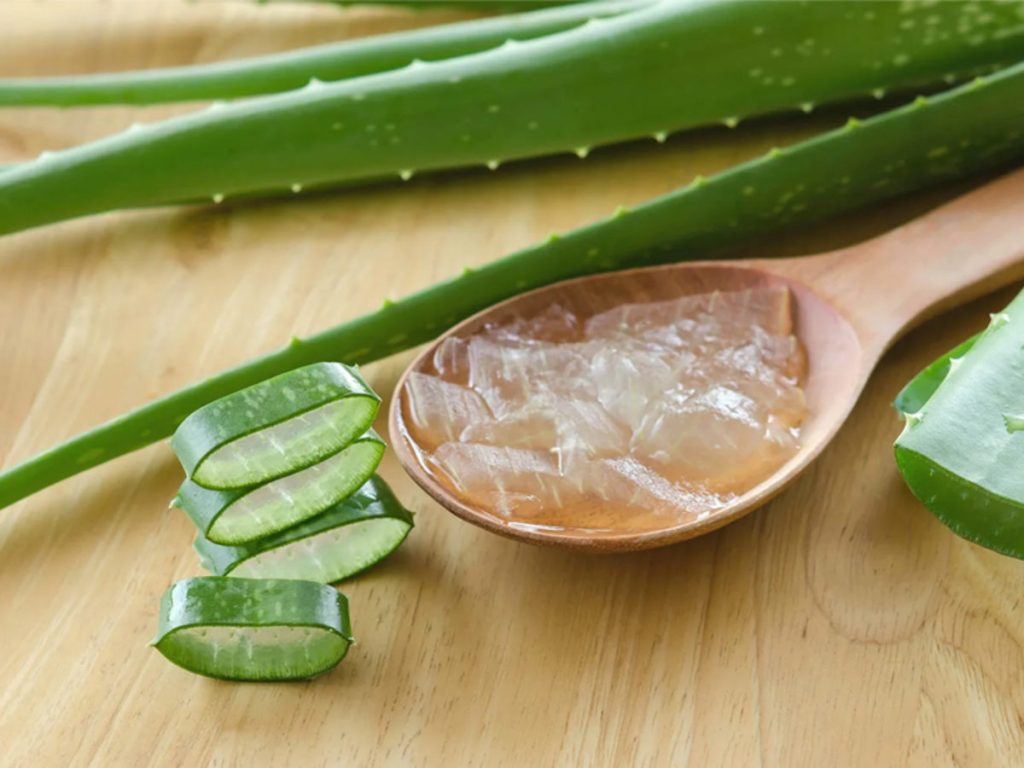Aloe vera celebrated for its myriad health benefits, is not only renowned for its soothing properties but also for its distinctive taste.
However, it boasts a mild, slightly bitter taste complemented by a hint of sweetness, akin to a blend of spinach with a touch of citrus. The gel, the commonly consumed part, is smooth and gel-like, offering a refreshing and hydrating experience.
Further, its texture is slippery and may feel a bit slimy, but when paired with sweet or tangy flavors like berries or citrus fruits, it transforms into a more enjoyable and palatable option.
Let’s unravel the nuances of Aloe vera’s taste, discovering the subtle complexities that make it a subject of both curiosity and culinary innovation.
Varieties of Aloe Vera: A Comprehensive Overview

| Variety | Description | Common Uses |
| Aloe Barbadensis Miller | Most common and widely used variety. Known for its medicinal properties and soothing gel. | Topical application for skin conditions, internal consumption for health benefits. |
| Aloe Aristata (Lace Aloe) | Features white speckles and a rosette shape. Often grown ornamentally with similar gel properties. | Ornamental plant, occasional topical use for skin care. |
| Aloe Polyphylla (Spiral Aloe) | Recognized for its stunning spiral arrangement of leaves. Not as common in skincare but adds aesthetic value. | Mostly grown for aesthetic purposes. |
| Aloe Ferox | Native to South Africa, is prized for its potent gel and latex. Used in wellness and skincare products. | Skincare products, wellness applications, and internal use in controlled amounts. |
| Aloe Vera Gel | Extracted from the inner leaf, is commonly used topically for skin benefits. Can be consumed for internal health. | Topical application for skin conditions controlled internal consumption. |
Nutritional Value
| Nutrient | Amount per 100g |
| Calories | 4 |
| Water | 96g |
| Protein | 0.1g |
| Carbohydrates | 1g |
| Fiber | 0.5g |
| Sugars | 0g |
| Fat | 0g |
| Vitamin C | 8.5mg (14% DV) |
| Vitamin E | 0.15mg (1% DV) |
| Folate | 2μg (1% DV) |
| Choline | 0.5mg |
| Calcium | 8mg (1% DV) |
| Iron | 0.8mg (4% DV) |
| Magnesium | 8mg (2% DV) |
| Phosphorus | 8mg (1% DV) |
| Potassium | 9mg |
| Sodium | 7mg |
| Zinc | 0.1mg (1% DV) |
Benefits of Eating Aloe Vera:
Eating aloe vera gel can be good for you. Here are some things it might help with
- Blood Sugar: Aloe vera gel might lower blood sugar levels by helping insulin work better.
- Inflammation: Aloe vera could calm down signals that cause inflammation in the body.
- Less Plaque: Using its juice as mouthwash might be as good as a regular mouthwash for keeping your teeth clean.
- Memory Boost: In animals, eating aloe vera gel improved memory and made animals feel less sad.
- Antioxidants: It has stuff that fights against things in your body that can make you sick.
Warnings about Eating Aloe Vera:
Be careful with aloe vera latex, the yellow stuff inside the leaf. Small amounts might help with constipation, but too much can be bad. The FDA banned selling products with aloe vera latex without a prescription.
Also, long-term use of aloe vera latex can cause problems like stomach cramps, kidney issues, weird heartbeats, and weak muscles. Taking too much, over 1 gram per day, can even be deadly.
Important Points:
- Pregnant women should not eat aloe vera latex because it might cause a miscarriage.
- If you have tummy problems like IBD or Crohn’s disease, don’t eat aloe vera latex – it can make things worse.
- If you’re on meds for diabetes, heart, or kidneys, eating aloe vera gel might not be a good idea. It could make the side effects worse.
- Don’t eat aloe vera skin care gels they’re not meant to be eaten and might have things that aren’t good for you.
So, while aloe vera gel can be good, be careful with the yellow latex inside the leaf, and if you’re pregnant or on certain meds. And don’t munch on those skincare gels.
Culinary Uses of Aloe Vera
| Culinary Application | Description |
| Smoothies and Juices | Blend aloe vera gel with various fruits for a refreshing and nutritious beverage. |
| Salads | Add diced one to salads to introduce a unique texture and subtle flavor. |
| Sauces and Dressings | Mix it into sauces or dressings for a healthful twist, combining it with herbs and citrus flavors. |
| Desserts | Create aloe vera-infused desserts such as sorbets, popsicles, or gelato, blending it with fruits or a creamy base. |
| Aloe Vera Tea | Brew aloe vera tea by steeping dried aloe vera pieces in hot water for a soothing and herbal alternative to regular tea. |
| Aloe Vera Yogurt Parfait | Layer one with yogurt and granola for a wholesome parfait, adding a unique texture and subtle flavor. |
| Aloe Vera Salsas | Dice aloe vera gel and include it in fresh salsas for a surprising twist, combining it with traditional salsa ingredients. |
| Aloe Vera Cocktails | Create refreshing cocktails by blending aloe vera gel with fruits and spirits, promoting moderation and responsible drinking. |
| Aloe Vera Infused Water | Add aloe vera gel to water for a subtle flavor boost, optionally combining it with cucumber or mint for extra refreshment. |
| Aloe Vera Energy Bites | Incorporate finely chopped aloe vera gel into energy bites or bars for a nutritious snack, combining it with nuts, seeds, and dried fruits. |
Choosing Tastier Alovera Options
Making Aloe Vera taste better is easy, and you don’t have to eat it raw. There are tastier ways to get its health benefits.
Alternatives to Eating Raw Aloe:
Instead of dealing with the raw plant, try it supplements or gel extracts. You can find them in capsules or as a gel extract. Choose what works for you:
- Capsules: Easy to take, no taste, and great for busy people. They give you all the benefits without the hassle.
- Extract: It is turned into a juice that’s easy to use in recipes or on its own. It’s quicker than preparing raw Aloe and doesn’t have the bitter aloin from the outer part.
- Aloe Juice: Mix it into smoothies or drinks to hide the taste if you’re not a fan.
Why AloeCure Stands Out:
AloeCure does things differently. Most Aloe Vera products use methods like charcoal filtration or added enzymes, which can strip away natural components. AloeCure has a special process that removes aloin naturally, without losing other important stuff in Aloe Vera. Their Aloe is processed within 12 hours of harvest to keep all the good nutrients.
Things to Consider:
When choosing a supplement, check if it’s organic Aloe Vera. Some products have little or almost no Aloe Vera. Also, look at the ingredients and avoid unnecessary fillers or additives. It should always be the first ingredient, or you might not be getting what you expect.
Enhancing the Flavor of Aloe Vera: 5 Ingenious Tips and Tricks

In the ever-expanding realm of health and wellness, It has secured its place as a sought-after supplement. Although its health benefits have been acknowledged for centuries, the challenge remains aloe vera doesn’t exactly win any taste awards on its own. Raw aloe has been likened to a bitter mix of spinach and battery acid, hardly an enticing prospect for many.
However, fear not. There are clever ways to transform aloe vera into a tasty treat, ensuring you can reap its benefits without enduring the less-than-pleasant flavor.
- Opt for Flavored Aloe Juice:
-
- Begin by extracting juice from the aloe vera plant and blending it with other flavorful juices. The bitterness of aloe pairs well with sweet and tangy flavors. Consider combining it with lemon, various berries, pomegranate, or even mint for a refreshing twist.
- Craft an Aloe Salad:
- Think beyond the conventional juices and smoothies. Why not incorporate aloe into a salad? Create a tantalizing Aloe Mint Summer Salad with fresh mint, tomatoes, lime, and a medley of spices. The acidity from tomatoes and citrus elements can beautifully balance aloe’s bitterness.
- Experiment with Aloe and Alcohol (Responsibly!):
- For those who enjoy an occasional alcoholic beverage, try mixing aloe into your cocktail repertoire. An Aloe Martini or Aloe Jello Freezes can add a unique twist. However, always remember to drink responsibly and be mindful of your alcohol consumption.
- Delight in Aloe-Infused Frozen Treats:
- If you lean towards frozen delights without the alcohol, consider whipping up Kiwi Aloe Popsicles or a Five-Ingredient Aloe Ice Cream. These recipes promise a sweet and cool indulgence while incorporating the goodness of aloe.
- Opt for Capsules or Extracts:
- If the taste of aloe remains unappealing, explore the option of aloe capsules or extracts. These concentrated forms retain the benefits without the need to savor the unique flavor. Simply swallow a capsule and enjoy the advantages of aloe without the taste challenge.
Whether you’re blending aloe into a refreshing drink, adding it to a salad, creating an enticing cocktail, freezing it into a delightful treat, or opting for capsules, there’s a method to suit every palate. Embrace the versatility of aloe vera and make your wellness journey a flavorful one!
FAQ’s
What does real aloe vera taste like?
It has a slightly bitter, citrusy flavor.
Is aloe vera Sweet or bitter?
Yes, If you plan to eat your Aloe Vera raw, you’ll find its taste slightly bitter, watery, with a hard-to-place sweetish bite at the end.
What flavor is aloe vera?
Aloe vera has a deliciously refreshing flavor that’s slightly tangy and a little bitter.
Can you eat aloe vera raw?
Yes, you can eat the gel raw or cooked. To prepare it, peel the leaf, cut off the spiky top and sides, then slice off one side of the skin lengthwise.
Are aloe drinks healthy?
Yes, Aloe vera juice is a rich source of antioxidants, lowering oxidative stress and reducing the risk of chronic conditions such as diabetes, heart disease, and cancer.
Is aloe vera gel tasteless?
Yes, Aloe vera gel is clear, odorless, and tasteless when obtained from the lower leaves of the plant.
Can I chew aloe vera?
Yes, you can eat both the clear gel and yellow latex in the leaf, with the gel having several health benefits.
Is aloe vera drink tasty?
No, Aloe water is typically on the bitter side, so it’s often combined with sweeteners or juice to enhance its taste.
Final Words
To sum up, aloe vera has a unique flavor profile characterized by a mild bitterness with subtle sweetness. The gel, extracted from the plant, has a smooth and slightly slimy texture. While some may find its raw taste challenging, incorporating it into recipes with sweet and tangy elements can significantly enhance its palatability.
Finally, aloe vera’s taste is versatile, allowing for creative and enjoyable culinary experiences when paired thoughtfully with other flavors.










